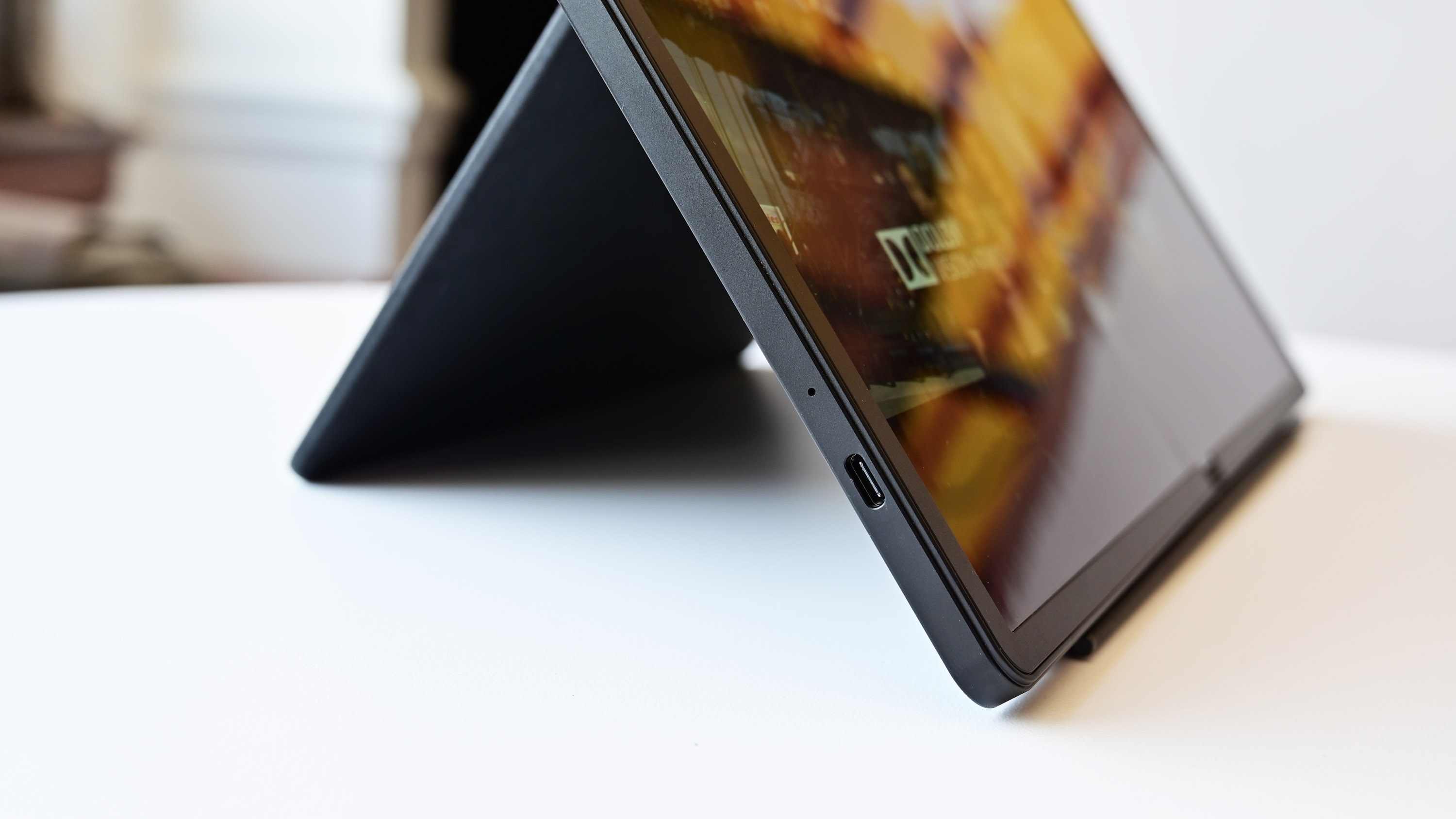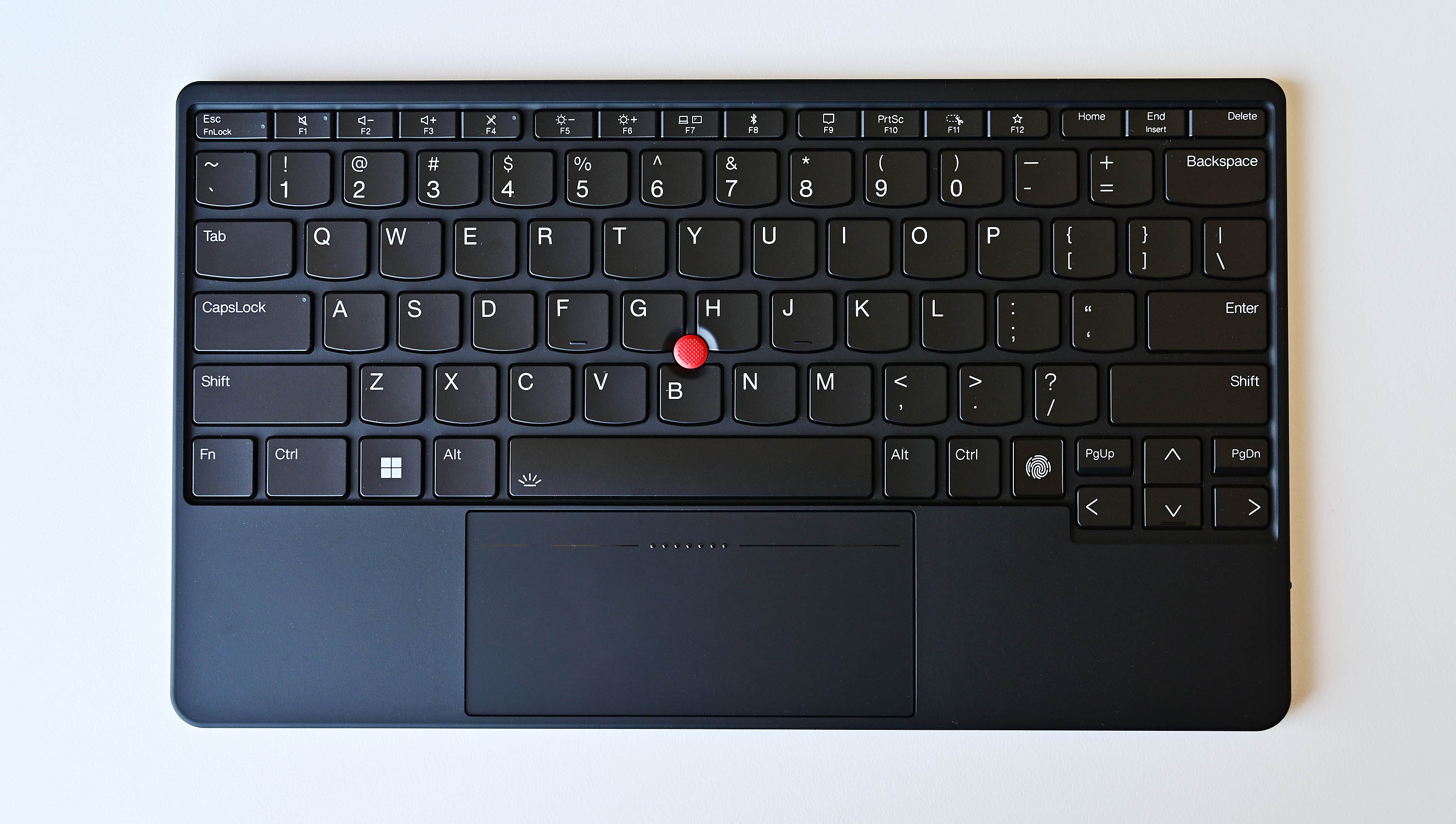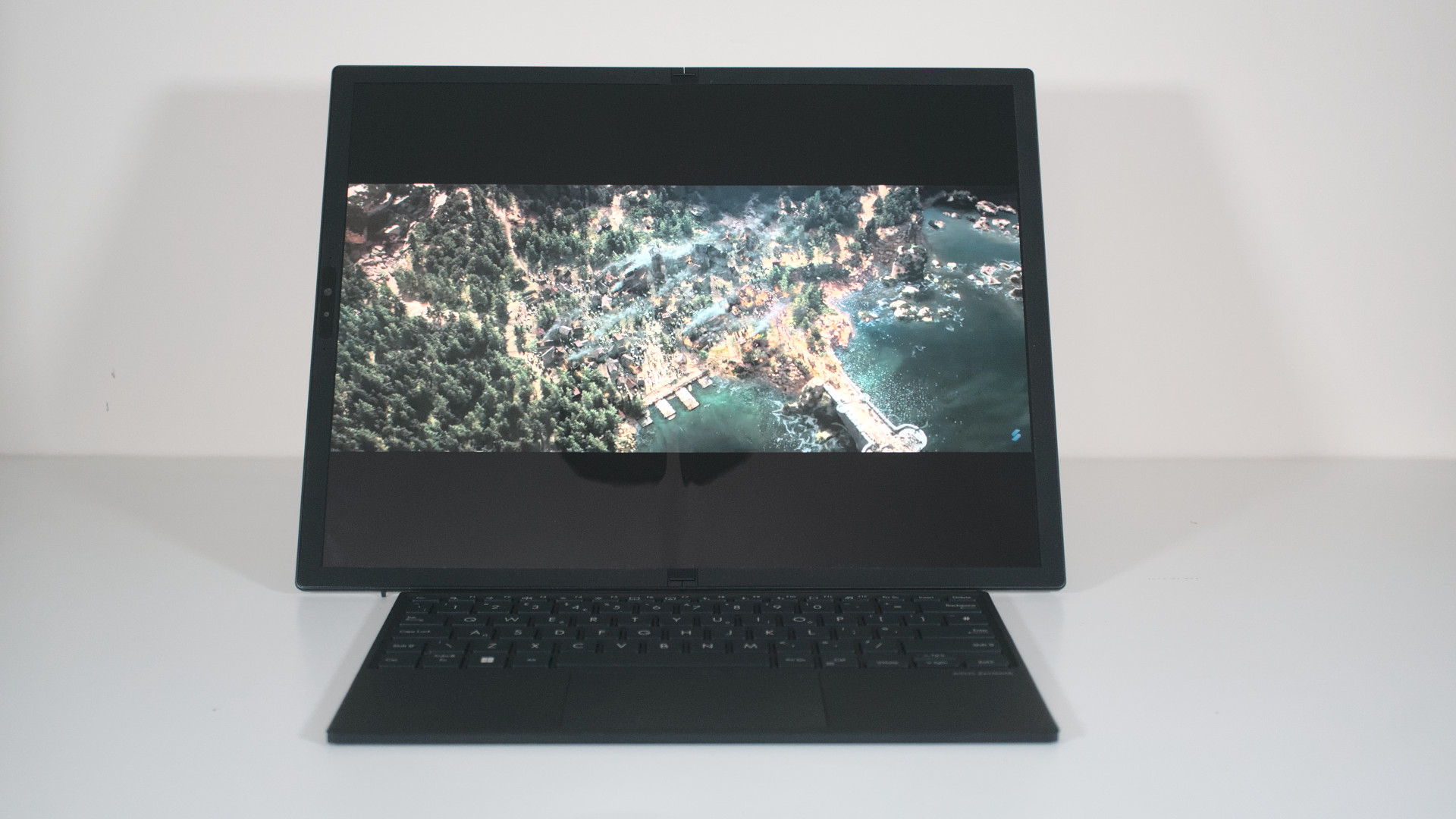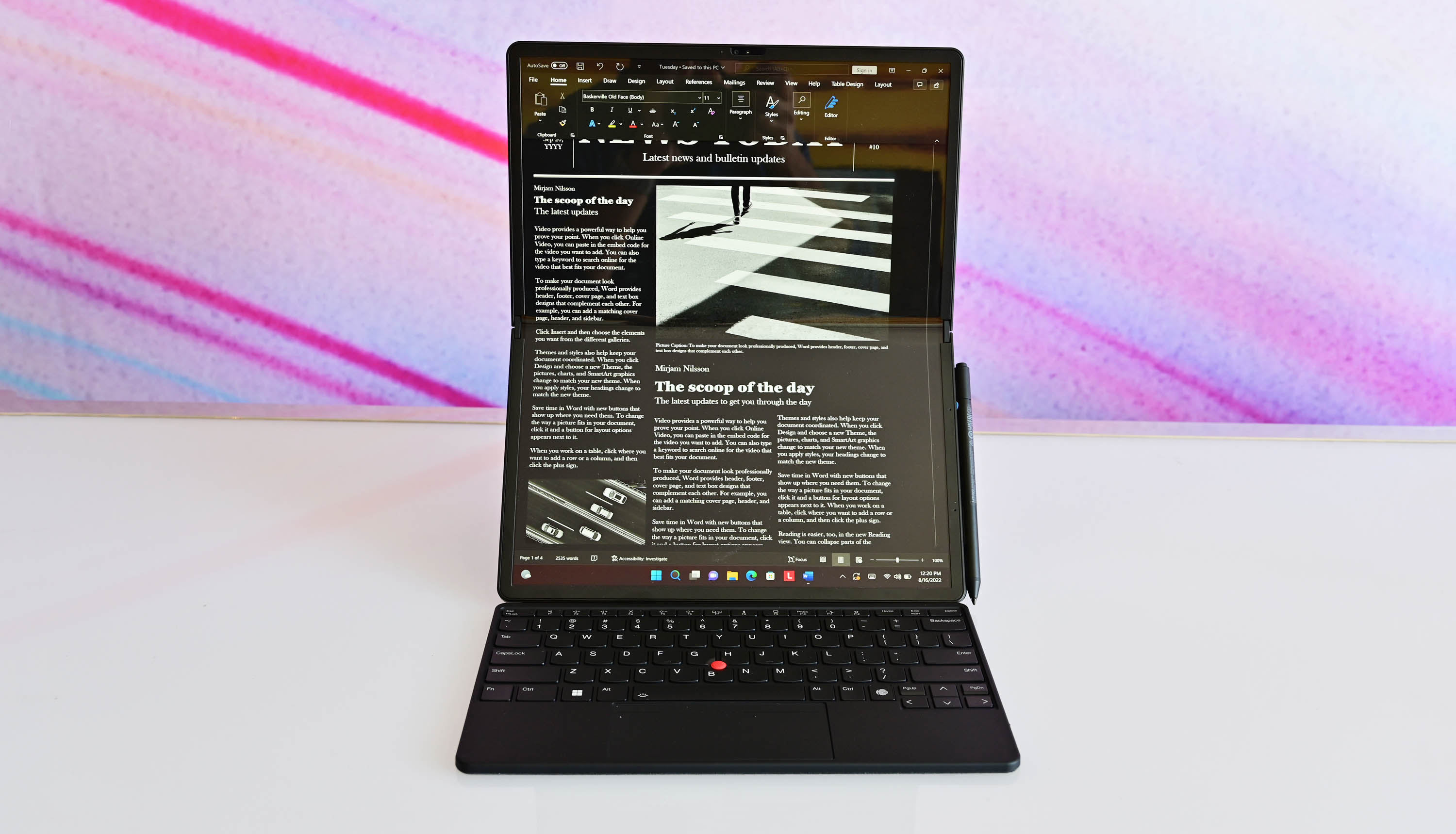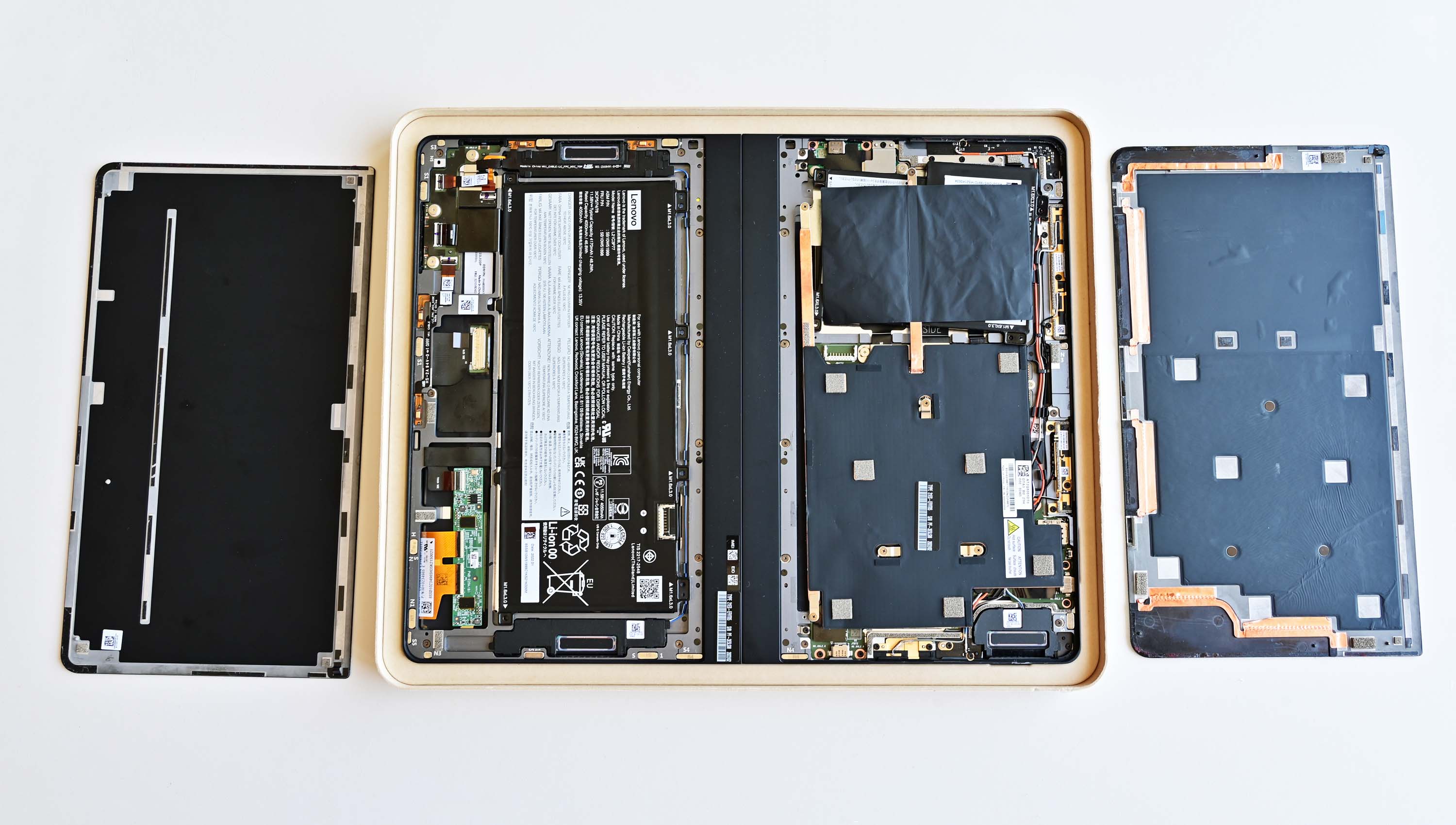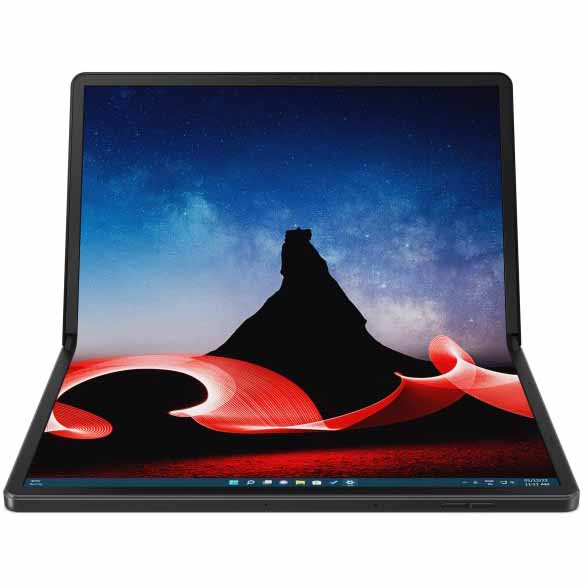
The second-gen ThinkPad X1 Fold, notably having a larger 16.3-inch display and 12th Gen Intel Core U-Series CPUs (with many more improvements, is expected to launch November 2022 starting at about $2,500.
Pros
- No visible display crease, folds flat like a book
- 12th Gen Intel Core U-Series CPUs
- Real ThinkPad keyboard with haptic touchpad
- Five postures for extreme versatility
- Overall beautiful craftsmanship
Cons
- Three-part stand, keyboard, and PC setup is a bit clumsy
- Windows 11 still has some work to do

The ASUS Zenbook 17 Fold is available now starting at about $3,500. It has a larger display and many similar features as the X1 Fold, but its first-gen status has it behind Lenovo's second-gen PC when it comes to overall features and usability.
Pros
- Gorgeous 17-inch folding display
- Stunning craftsmanship
- Six different modes for added versatility
- Kickstand is built right in
- Magnetic keyboard and touchpad
Cons
- No 5G
- Expensive
- Gap when folded, display crease still visible
- No inking
Availability, price, and specs
Lenovo's first-gen X1 Fold premiered a couple of years ago, never really getting out of its experimental status with a limited release. Still, it was a marvel of engineering that shook up the laptop space with its folding display, attachable keyboard, and overall versatility.
Lenovo took the next couple of years to rework nearly everything about the X1 Fold for its second generation. It packs in fanless 12th Gen Intel Core U-Series CPUs, a larger 16.3-inch display without folding gap or visible creasing, and a detachable kickstand that lets you mount the PC horizontally or vertically for use with the full-size ThinkPad keyboard and haptic touchpad. It's set to launch November 2022 with a starting price of about $2,500.
The ASUS Zenbook 17 Fold (UX9702) is a first-gen product that is nevertheless a marvel of engineering in its own right. ASUS hasn't had as much time to iron out the fine details, so there are some drawbacks that might have you leaning toward Lenovo's folding PC. There's also the fact that it starts at a much higher price. Paying upwards of $3,500 for the Zenbook 17 Fold might not seem that intriguing when the X1 Fold is set to launch in a couple months for $1,000 less, but at least it's available now.
Here's a look at the specifications that make up each laptop.
| Header Cell - Column 0 | ThinkPad X1 Fold (Gen 2) | ASUS Zenbook 17 Fold (UX9702) |
|---|---|---|
| OS | Windows 11 Home, Windows 11 Pro | Windows 11 Pro |
| Processor | 12th Gen Intel U-Series vPro | 12th Gen Intel |
| Row 2 - Cell 0 | Core i5, Core i7 | Core i7-1250U |
| RAM | Up to 32GB LPDDR5 | 16GB LPDDR5 |
| Graphics | Intel Iris Xe | Intel Iris Xe |
| Storage | Up to 1TB M.2 PCIe 4.0 SSD | 1TB M.2 PCIe 4.0 SSD |
| Display | 16.3 inches, foldable, touch, inking | 17.3 inches, foldable, touch |
| Row 7 - Cell 0 | 2024x2560, OLED, 600 nits (HDR), 400 nits (SDR), 100% DCI-P3, Dolby Vision, | 2560x1920, OLED, 500 nits (HDR), 100% DCI-P3, Dolby Vision |
| Ports | Two Thunderbolt 4, USB-C 3.2 (Gen 2) | Two Thunderbolt 4, 3.5mm audio |
| Audio | Three speakers, Dolby Atmos | Four speakers, Dolby Atmos |
| Wireless | Wi-Fi 6E, Bluetooth 5.2, 5G | Wi-Fi 6E, Bluetooth 5 |
| Camera | 5MP RGB + IR hybrid | 5MP, IR camera |
| Security | IR camera, fingerprint reader | IR camera, TPM |
| Battery | 48Wh (16Wh extra optional) | 75Wh |
| Dimensions | Unfolded: 10.87 x 13.6 x 0.34 inches (276.1mm x 345.7mm x 8.6mm) | 14.9 x 11.32 x 0.34-0.51 inches (378.5mm x 287.6mm x 8.7-12.9mm) |
| Row 15 - Cell 0 | Folded: 6.9 x 10.87 x 0.68 inches (176.4mm x 276.2mm x 17.4mm) | Row 15 - Cell 2 |
| Weight | PC: 2.82 pounds (1.28kg) | 3.31 pounds (1.5kg) |
| Row 17 - Cell 0 | Full setup: 4.19 pounds (1.9kg) | Row 17 - Cell 2 |
Design and features
Lenovo and ASUS have each created a laptop that is essentially one large display hiding all required internal components, with the ability to fold down the middle to close up like a book. Because the space traditionally reserved for a keyboard and touchpad is now also screen space, each laptop has a separate wireless keyboard portion that attaches magnetically to the PC.
This allows each PC to function in a number of different modes. You can open it up flat like a tablet or prop it up "sideways" like a screen with the keyboard in front. You can fold it down the middle and set it up vertically, attaching the keyboard to the bottom half of the screen (or use the on-screen keyboard). You can even give the screen a half fold and hold it like a book.
The Zenbook 17 Fold has a built-in kickstand that facilitates some of the different modes, whereas the X1 Fold has a separate kickstand that you have to add on to the back when required. This does add some clumsiness, as you essentially have three parts to deal with when the keyboard is included.
All the latest news, reviews, and guides for Windows and Xbox diehards.
You can also use the keyboards next to each laptop (as long as they're within wireless distance), and they have their own built-in batteries that must be charged up. The Zenbook's keyboard is a lot like most of the other ASUS keyboards, with 1.4mm key travel and slightly cupped keys. Lenovo has gone with what Executive Editor Daniel Rubino says is "effectively the same keyboard as the ThinkPad X1 Nano with one big difference" in his hands-on X1 Fold (Gen 2) preview. That different is a haptic touchpad that feels a lot like the one on the ThinkPad X1 Titanium Yoga.
The X1 Fold (Gen 2) has three speakers, with two that function at any one time. They're tuned with Dolby Atmos for deeper audio and spatial abilities. The Zenbook 17 Fold goes with a quad-speaker setup, also with Dolby Atmos tuning. Speakers live on the sides and back of the device, ensuring you get unmuffled sound no matter how you're using it. A Smart Amp adds a ton of volume (ASUS claims 350% more volume) without distortion.
To go with the speakers, each PC has a 5MP webcam embedded in the display bezel. Both laptops offer an IR camera for Windows Hello, as well as human presence detection abilities. That means you can walk away from either laptop and have it lock automatically, only to unlock when it sees you approach. The X1 Fold features Intel's VSC tech that allows the camera to auto-frame no matter the orientation, something especially important with this type of device.
As for ports, the selection in both laptops is rather spartan. The X1 Fold has two Thunderbolt 4 and one USB-C 3.2 (Gen 2). The Zenbook 17 Fold has the same dual Thunderbolt 4 setup but adds a 3.5mm audio jack instead of extra USB-C. Considering both keyboards charge via USB-C, having that extra port on the X1 Fold might come in handy if you absolutely need both Thunderbolt ports.
You can also connect either laptop to a powerful Thunderbolt 4 docking station for even more connectivity. Wi-Fi 6E is on board both laptops, as is modern Bluetooth. Only the X1 Fold offers 5G connectivity, so anyone who likes staying connected everywhere will have to stick with Lenovo.
Foldable displays
The real draw to both of these laptops is the folding display. Both Lenovo and ASUS displays are oversized at 16.3 inches and 17.3 inches, respectively, providing plenty of space even when folded (about 12 inches). That's still a respectable size that shouldn't impede most workflows. Both displays have relatively thin bezel, with just a bit of surface to hold onto when in tablet mode.
The ASUS OLED touch display is quite stacked, with 100% sRGB, 95% AdobeRGB, and 100% DCI-P3 color reproduction, as Senior Editor Rich Edmonds discovered in his ASUS Zenbook 17 Fold review. It also managed about 500 nits brightness with HDR enabled. The 2560x1920 resolution is crisp, Dolby Vision makes watching supported content even more of a joy, and there are a number of TÜV Rheinland certifications for low blue light and flicker-free picture.
Lenovo isn't to be outdone, offering up a 2024x2560 resolution, OLED panel, 600 nits brightness with HDR, 100% DCI-P3 color, and Dolby Vision. It's a touch display, of course, but unlike the ASUS PC you get inking support here.
Most notably — and what will likely attract a lot of people to the X1 Fold (Gen 2) — is its lack of visible crease when open and lack of "gap" between PC portions when closed. It essentially feels like a book when closed up. The Zenbook 17 Fold, by comparison, still has a gap when closed and there's a visible crease when open ... at least when the display isn't powered on. Chalk this difference up to Lenovo having more time to make changes after its first-gen X1 Fold.
Performance hardware
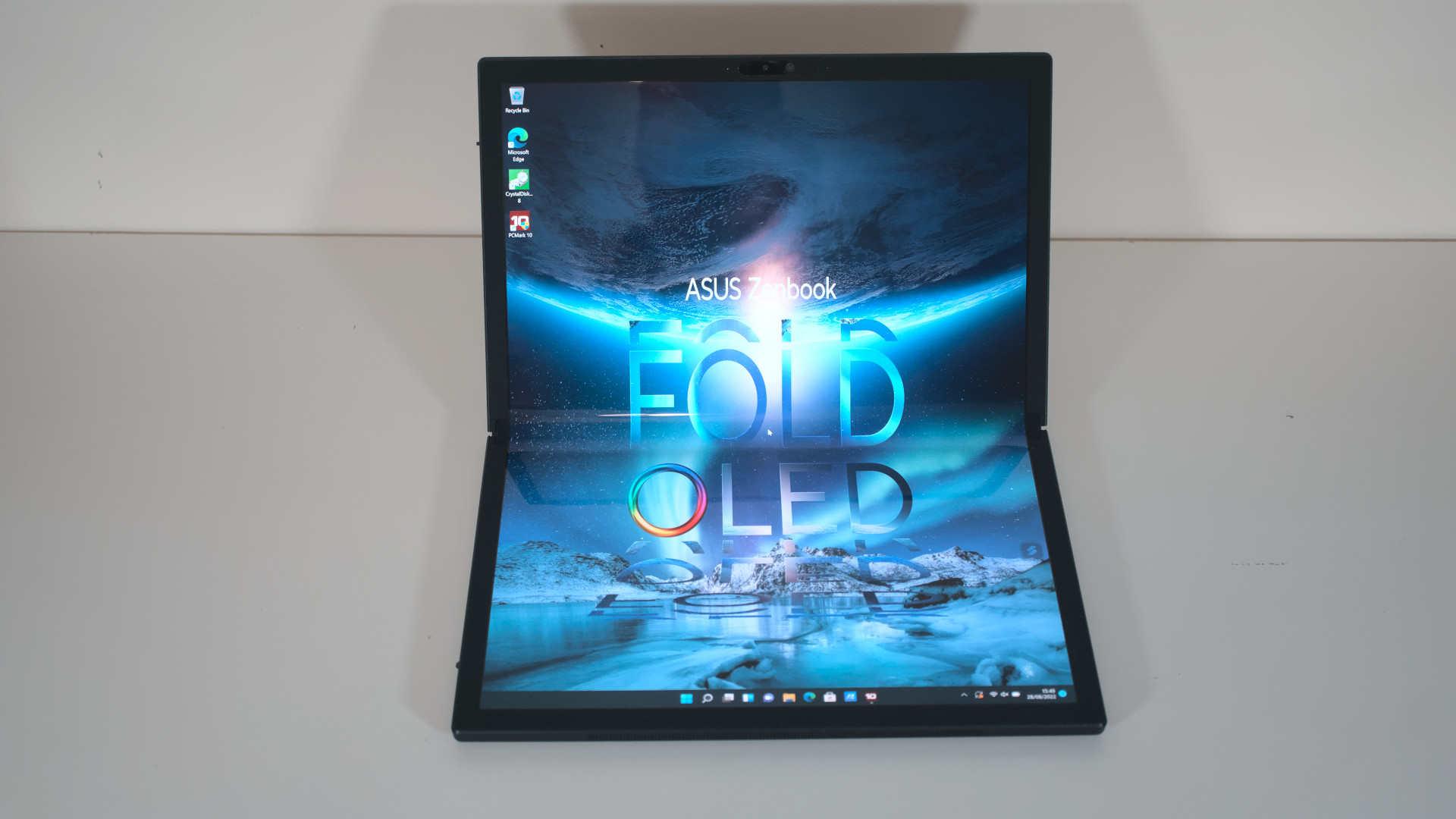
Both laptops feature 12th Gen Intel Core mobile CPUs. More specifically, you can get either a Core i5 or Core i7 U-Series chip in the X1 Fold, while the Zenbook 17 Fold comes with a Core i7-1250U. The i7-1250U is capable of support vPro Essentials, which includes some device management and Intel's Hardware Shield.
Because the X1 Fold belongs to the ThinkPad lineup, its i5 or i7 CPUs should offer the full Enterprise vPro suite that's better suited for large corporations with IT management admins taking care of devices. The X1 Fold is fanless, while the Zenbook 17 Fold has an included (but nearly silent) fan.
The X1 Fold comes with up to 32GB of LPDDR5 RAM and a 1TB M.2 PCIe 4.0 SSD. The Zenbook 17 Fold comes with up to 16GB of LPDDR5 RAM and a 1TB M.2 PCIe 4.0 SSD. Both laptops feature integrated Intel Iris Xe graphics.
Battery life as tested in-house is good on the Zenbook 17 Fold, with about 14 hours of life going about everyday tasks with the keyboard attached. Going with a full screen setup reduces that number to about 10 hours. We will have to perform our own tests to see what the X1 Fold's battery is capable of. It has a stock 48Wh battery that can be upsized by another 16Wh depending on the configuration you opt for at checkout.
One other important X1 Fold (Gen 2) feature is its serviceability. Lenovo has ensured that its second-gen model can be repaired, relying much less on heavy glue and permanent fixtures to keep everything in place. The front and rear covers can be removed, you can swap out SSDs, the battery can be replaced, and more. This is a big step up from the first-gen model. The Zenbook 17 Fold's innards can also be accessed, allowing for upgrades to its SSD, battery, and other hardware.
The ThinkPad X1 Fold should take a strong position in our list of the best Lenovo laptops when it launches in November, while the ASUS Zenbook 17 Fold is already one of the overall best Windows laptops for those who love experimental designs and high-end features.

The ASUS Zenbook 17 Fold is available now, but it does cost quite a bit more than the X1 Fold. Its folding display isn't quite as refined as the one in the new X1 Fold, but this is still a killer laptop that is impossible to beat when it comes to versatility and high-end features.

Cale Hunt brings to Windows Central more than nine years of experience writing about laptops, PCs, accessories, games, and beyond. If it runs Windows or in some way complements the hardware, there’s a good chance he knows about it, has written about it, or is already busy testing it.
